
Grain varieties suitable to the backyard
One
of the biggest stumbling blocks for me in growing my own grain was that
I just didn't know where to start. There are at least a dozen
grains available in the grocery store, but since none of my neighbors
grow any of them, I didn't know which ones are suited to my climate and
to my uses.
Here's a quick rundown
on the pluses and minuses of various types of
grain, from the backyard perspective. I've put the most promising
varieties near the top so that you can stop reading if you get bored.
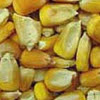 Corn
is the king of high output per unit area, but low protein. This
is the only grain commonly grow in the backyard, for a good
reason. You can easily harvest corn on a small scale, picking the
corn and shelling it by hand or in a hand-cranked sheller. Corn
makes up the bulk of many animal feeds and is, indeed, a cheap and easy
way to start breaking your dependence on storebought feed.
Corn
is the king of high output per unit area, but low protein. This
is the only grain commonly grow in the backyard, for a good
reason. You can easily harvest corn on a small scale, picking the
corn and shelling it by hand or in a hand-cranked sheller. Corn
makes up the bulk of many animal feeds and is, indeed, a cheap and easy
way to start breaking your dependence on storebought feed.
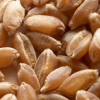
Wheat
is the other primary grain that Americans eat, and you can't beat the
taste. As a backyard grain, it's harder than corn but easier than
many others. It can be used as animal feed and can also be grazed
by livestock in the spring without unduly affecting your grain harvest.
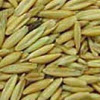 Oats
are one of the best grains, health-wise, due to their high protein
content. They are a bit more difficult than wheat since the seeds
are coated in a tough hull that is difficult to remove at home, but I
plan to try a hull-less oat variety that lacks that problem. In
addition to being used as human and animal food, oats were
traditionally grown as a cover crop for strawberries in England.
The oats were planted in late summer to early fall between the
strawberry plants, grew for a while, then were naturally killed by
frost before setting seed. The grass-like plants fell and mulched
the berries --- how can you beat a mulch that spreads itself?
Oats
are one of the best grains, health-wise, due to their high protein
content. They are a bit more difficult than wheat since the seeds
are coated in a tough hull that is difficult to remove at home, but I
plan to try a hull-less oat variety that lacks that problem. In
addition to being used as human and animal food, oats were
traditionally grown as a cover crop for strawberries in England.
The oats were planted in late summer to early fall between the
strawberry plants, grew for a while, then were naturally killed by
frost before setting seed. The grass-like plants fell and mulched
the berries --- how can you beat a mulch that spreads itself?
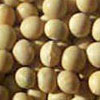 Soybeans
clearly aren't grains, but Gene Logsdon includes them in his book
because they make up the other major portion of commercial animal feeds
and are a great source of protein. They are grown like garden
beans,
and can be eaten at the green stage (aka the delicious edamame you
might have
tried as an appetizer in a Japanese restaurant) or dried and used like
soup beans. Soybeans also make a good hay and green manure.
When
feeding to animals, though, you shouldn't feed soybeans raw because the
beans contain a substance that interferes with digestion and protein
absorption. As long as you roast the beans first, they are a
cheap and
easy way to add protein to your chickens' diets.
Soybeans
clearly aren't grains, but Gene Logsdon includes them in his book
because they make up the other major portion of commercial animal feeds
and are a great source of protein. They are grown like garden
beans,
and can be eaten at the green stage (aka the delicious edamame you
might have
tried as an appetizer in a Japanese restaurant) or dried and used like
soup beans. Soybeans also make a good hay and green manure.
When
feeding to animals, though, you shouldn't feed soybeans raw because the
beans contain a substance that interferes with digestion and protein
absorption. As long as you roast the beans first, they are a
cheap and
easy way to add protein to your chickens' diets.
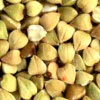 Buckwheat
is only kinda-sorta a grain as well. (It's in the smartweed
family
instead of the grass family.) One of our readers suggested that
we
give this a shot, and I have to admit that it looks like a homestead
winner. Buckwheat is high in lysine, an amino acid that other
grains
lack, and is a dynamic accumulator
of phosphate. It can be planted in early summer when gaps start
opening in the garden from spring crops, and the fall flowers are an
excellent source of nectar for honeybees. You can go the normal
route
of threshing and winnowing, or just pick a cup or two by hand in the
garden. Logsdon reports that his chickens love buckwheat.
Buckwheat
is only kinda-sorta a grain as well. (It's in the smartweed
family
instead of the grass family.) One of our readers suggested that
we
give this a shot, and I have to admit that it looks like a homestead
winner. Buckwheat is high in lysine, an amino acid that other
grains
lack, and is a dynamic accumulator
of phosphate. It can be planted in early summer when gaps start
opening in the garden from spring crops, and the fall flowers are an
excellent source of nectar for honeybees. You can go the normal
route
of threshing and winnowing, or just pick a cup or two by hand in the
garden. Logsdon reports that his chickens love buckwheat.
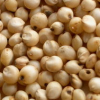 Sorghum
is a grain I've never eaten but one that my neighbors actually
grow. You can grow grain sorghum (aka "milo") specifically for
the edible seeds or grow sweet sorghum and use the stalks for molasses
and the grain for food. Sorghum has yields as high as corn, and
is very easy to harvest for animal feed since you can just cut the
entire seed head and toss it to your chickens. Threshing is also
easier than other grains --- just rub the sorghum heads between your
hands and the seeds will drop right out.
Sorghum
is a grain I've never eaten but one that my neighbors actually
grow. You can grow grain sorghum (aka "milo") specifically for
the edible seeds or grow sweet sorghum and use the stalks for molasses
and the grain for food. Sorghum has yields as high as corn, and
is very easy to harvest for animal feed since you can just cut the
entire seed head and toss it to your chickens. Threshing is also
easier than other grains --- just rub the sorghum heads between your
hands and the seeds will drop right out.
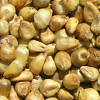
Millet isn't often used for human
food in the U.S., but is a primary grain in northern China. Pearl
millet (Pennisetum
glaucum)
seems to have potential for the backyard since it threshes free from
the hulls naturally, and chickens can be fed a whole seed head, as with
sorghum.

Rye has the most potential as a
pasture plant since it is very tolerant of cold weather and will stay
green all winter. Unless you love the flavor of the grain (which
I don't), there's no real reason to grow it for grain the backyard.

Barley makes good livestock feed
and beer, but is also not one of the top backyard grains.
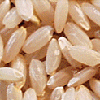
Rice
is, unfortunately, a backyard loser. The grain requires at least
forty days with minimum temperatures greater than 70 degrees
Fahrenheit, conditions that can be found in Arkansas, Louisiana, Texas,
and California, but not Virginia.
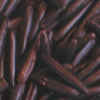
Wild
Rice is a
delicious,
native North American alternative to cultivated rice.
Unfortunately, we are again outside its range. You might try
growing wild rice if you live in New England or the Midwest.
| This post is part of our Backyard Grain Growing lunchtime series.
Read all of the entries: |
Want more in-depth information? Browse through our books.
Or explore more posts by date or by subject.
About us: Anna Hess and Mark Hamilton spent over a decade living self-sufficiently in the mountains of Virginia before moving north to start over from scratch in the foothills of Ohio. They've experimented with permaculture, no-till gardening, trailersteading, home-based microbusinesses and much more, writing about their adventures in both blogs and books.
Want to be notified when new comments are posted on this page? Click on the RSS button after you add a comment to subscribe to the comment feed, or simply check the box beside "email replies to me" while writing your comment.

You must have really been left here by aliens if you don't like rye.
I grew millet as a cover crop last winter. Big mistake. Guess what weed took over my peanuts. I bet I hand weeded them a half dozen times. Don't grow it unless you pick every seed if you don't want it hanging around.
Good to know about millet self-seeding. That would put it lower down on the list of good grain crops...
Those aliens never fed me rye --- why would I like it?
Ana,
I got my oil extractor in the mail the other day! It looks very well made and came with two big bags of canola seed. I can't wait to try it out but since you have to attach it to a countertop I'm going to wait until we get to Virginia.